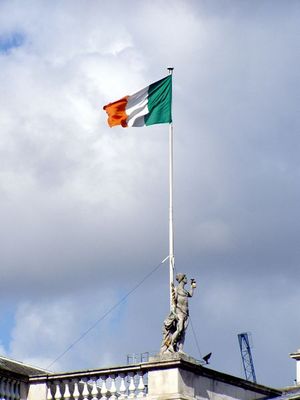Understanding the meanings behind the symbols associated with Ireland can help you gain a broader understanding of Irish culture or your own heritage. Whether you are looking to do further research or simply to learn a bit more for St. Patrick’s Day, enjoy this basic guide to Irish symbols.
Harp: The harp is a definitive symbol of Irish tradition, representing cultural appreciation of music and the bardic tradition. Despite many tragedies and hardships, songs and stories have supported and preserved Irish culture and language. Today, the harp is still heard as an accompanying instrument in many Celtic arrangements. It is featured prominently on the ‘Erin Go Bragh’ flagh, presented as gold on a green field. Carried by Irish units in the American Civil War, this traditional flag is still used to represent Ireland on the island and abroad and can be frequently spied in Irish-American establishments. Guinness also utilizes the harp to indicate their status as Ireland’s stout, and the lager produced by Guinness is branded as Harp.
Celtic Cross: Originally used as a pre-Christian device to stake out property and as a surveying tool, the Celtic cross has many uses in astrology and measurement. The adaptation of the Celtic cross to represent Irish Catholicism was a natural progression after St. Patrick introduced Christianity to Ireland. Today, the Celtic cross adequately represents Ireland’s unique brand of Christianity and the manner in which it embraces even older values.
Triskele: Found on Newgrange in County Meath, the triskele is a triple aspect symbol representing three parts of one whole. Archaeological dating methods now suggest that the triskele pattern and the stone into which it was carved was used as early as the bronze age. This ancient, evocative symbol still holds meaning today for many who worship the Catholic and pagan trinities.
Shamrock: This pleasant green plant was said to be used by St. Patrick to describe the housing of the trinity in one being. Also considered to be representative of the rich color of Ireland, celebrators in Ireland and abroad frequently wear a shamrock or shamrock-stylized jewelry to display their heritage. You will see many shamrocks on St. Patrick’s Day.
Irish flag-the tricolor: Used with increasing popularity in the early twentieth century, the Irish flag, commonly known as the tricolor, represents Catholic Ireland (the green), Protestant Ireland (the orange), and the peace to exist between them (the white). The tricolor increased in popularity around the time of the Easter Rebellion in 1916. It is now the official flag of the Republic of Ireland.
Images from the Book of Kells: This ancient illuminated manuscript is on display at Trinity College in Dublin. Most Celtic jewelry, knots, animal representations, font, lettering, and artwork come from or have been heavily influenced by this Irish national treasure.
Shillelagh: The shillelagh is a powerful and controversial image in Ireland-use it with care. While Americans and Australians typically associate this symbol with troublesome leprechauns, the shillelagh has a deeper meaning. Stickfighting, a native Irish martial art utilizing the shillelagh, existed in varying degrees of popularity throughout history to the present. Even when the Irish were banned from carrying weapons, many men would still be seen strolling about with a club-like cane made of sturdy, solid, unmistakable blackthorn. It has since been a power of symbol, resistance, nationalism, and tradition, and many object to it being trivialized as a leprechaun’s walking stick.
The Claddagh: Typically seen on rings, other jewelry, and dishware, this symbol features a heart with a crown atop it, enclosed by two loving hands. This symbol gained popularity in nineteenth century County Galway. The crown represents loyalty, the heart love, and the hands friendship. The placement of a Claddagh ring on a woman’s hand indicates her marital status (single, being courted, or married) and is extremely popular among Irish-Americans.
Many beautiful handmade items featuring these symbols can be purchased or created to display your Irish heritage or affinity for Irish culture. Whether ancient or recent, these symbols stir powerful emotions of pride and preservation.


